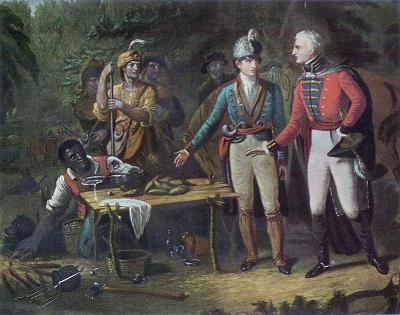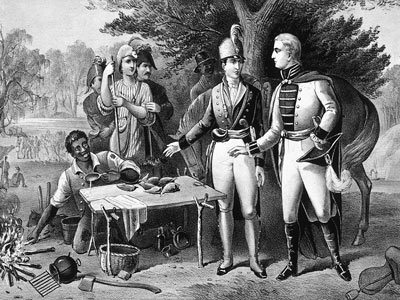 I received a lot of interesting feedback from my April 19th post dealing with the painting The Prayer at Valley Forge. Today I would like to examine another piece of artwork that has been the subject of debate.
I received a lot of interesting feedback from my April 19th post dealing with the painting The Prayer at Valley Forge. Today I would like to examine another piece of artwork that has been the subject of debate.
This oil on canvas painting titled General Marion Inviting a British Officer to Share His Meal, by South Carolina artist John Blake White, was presented to the U.S. Senate in 1899. According to a senate publication on the piece:
The artist has painted the red-coated British officer and Marion at right center, with a horse. Marion wears a plumed shako. His soldiers present an amusingly motley crew. Of special interest is the African American man behind the table, holding a small pan and, with his right hand, roasting sweet potatoes in the fire. This figure was likely meant to represent Marion’s slave or manservant, although Samuel Weaver’s pension application maintains that Weaver himself, a white soldier, was the one who cooked the meal. The makeshift table has a number of sweet potatoes on it, and Marion gestures toward them.
 White’s portrayal was made into this mezzotint print by John Sartain in 1840 for the Apollo Association for the Promotion of the Fine Arts in the United States. The image was later used on the 1861 Confederate ($5) banknotes that were issued by South Carolina. An exhibition catalogue dramatically described the story behind the image this way:
White’s portrayal was made into this mezzotint print by John Sartain in 1840 for the Apollo Association for the Promotion of the Fine Arts in the United States. The image was later used on the 1861 Confederate ($5) banknotes that were issued by South Carolina. An exhibition catalogue dramatically described the story behind the image this way:
After the business had been arranged, Marion invited the visitor to take dinner with him. The moment chosen by the Artist is when they approach the table, which was composed of pieces of bark, bearing a dinner of sweet potatoes. The expression of surprise on the countenances of the stranger and Marion’s men is finely expressed. The scenery is said to be perfectly characteristic of a South Carolina swamp; and, altogether, it may safely be pronounced one of the best pictures of American history ever produced in this country.
This version became the accepted interpretation of the piece until James P. Truluck, a descendant of the alleged British Officer, accused it of being revisionist history. According to Truluck, the depicted roles of Marion as host and the Englishman as guest were actually reversed. According to Truluck (in an 1989 article in Carologue, the journal of the South Carolina Historical Society), Captain John Brockington, Jr.—a landowner, slave-owner, and Tory sympathizer, who had fought against the “Swamp Fox”—was the legendary officer depicted in the piece. He added that his ancestor had been among the Tories that were banned to Nova Scotia after Continental forces assumed control of South Carolina.
In an effort to regain his land and reputation, Brockington returned to the colonies to refute his Loyalists ways and repay any claims that were made against him. After receiving a pardon, he and his slaves headed home and traveled through the swamps to avoid confrontation. It was while preparing their own camp meal that Truluck states Marion found them (resulting in the painted scene). He added that Brockington had extended an invitation to the “Swamp Fox” to join them - and joked that Marion had done the same.
Updated: Tuesday, 26 April 2011 1:49 PM EDT
Permalink | Share This Post





